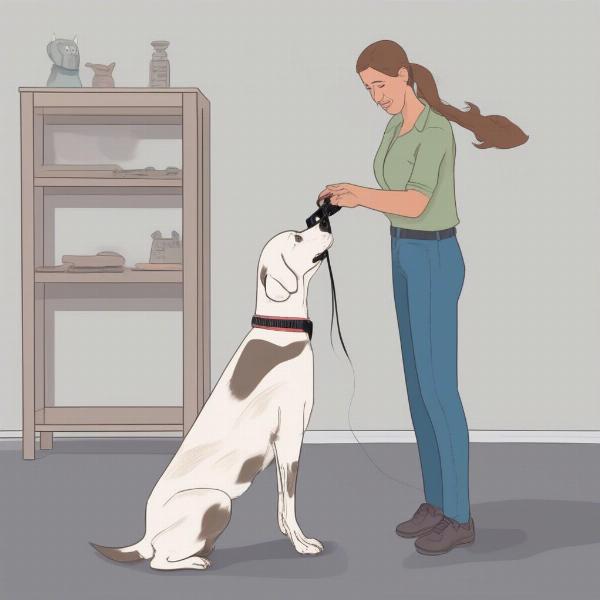Shock collars, also known as e-collars or training collars, vary significantly in price depending on features, brand, and intended use. You’re likely to find options ranging from $20 for basic models to over $200 for advanced systems with GPS tracking and multiple training modes. While cost is a factor, it’s crucial to prioritize the dog’s well-being and choose a collar that is safe, effective, and used responsibly. This article will guide you through the factors influencing shock collar prices and help you make an informed decision that benefits both you and your furry friend.
Decoding the Price of Shock Collars
Several factors contribute to the wide price range you’ll encounter when shopping for shock collars. Understanding these factors will empower you to choose a collar that fits your budget and training needs.
Features and Functionality
Basic shock collars offer limited stimulation levels and range, often suitable for simple training or addressing specific behavioral issues. These tend to be more affordable. As you move up the price scale, you’ll find features like vibration modes, tone-only options, and adjustable intensity levels. High-end models might include GPS tracking, remote training ranges of miles, and even bark detection technology.
Brand Reputation
Established brands with a history of producing reliable and safe dog training equipment often command higher prices. While lesser-known brands might offer cheaper alternatives, it’s important to research their reputation and ensure the product meets safety standards.
Intended Use
Shock collars designed for specific purposes, like containing a dog within an invisible fence system, might have different pricing compared to general training collars. The size of the dog also plays a role, with collars for smaller dogs sometimes being less expensive.
Finding the Right Shock Collar for Your Budget
It’s easy to get overwhelmed by the sheer number of options available. Here’s a breakdown to simplify the process:
Budget-Friendly Options ($20 – $50)
In this range, expect basic functionality with limited stimulation levels. These collars are often suitable for small to medium-sized dogs and addressing specific behaviors like excessive barking.
Mid-Range Choices ($50 – $150)
Mid-range collars offer more features, such as vibration and tone modes, along with greater control over stimulation intensity. They might also have a longer range for training in larger areas.
Premium Shock Collars ($150+)
These collars boast advanced features like GPS tracking, multiple training modes, and extended range. They’re ideal for professional trainers or owners who require precise control and monitoring.
Beyond the Price Tag: Prioritizing Safety and Ethical Use
Regardless of the price, the most crucial aspect of using a shock collar is responsible and ethical application. dog bark shock collar should be used as a training tool, not a punishment. Always prioritize positive reinforcement methods and consult with a professional dog trainer for guidance on proper usage.
Understanding the Impact of Shock
While the term “shock” sounds alarming, modern shock collars use static stimulation that is more akin to a tingling sensation. The intensity is adjustable, and responsible use involves starting at the lowest level and gradually increasing only if necessary.
 Safe and Ethical Shock Collar Use
Safe and Ethical Shock Collar Use
Conclusion
The price of a shock collar for dogs is influenced by features, brand, and intended use. You can find options ranging from affordable basic models to premium collars with advanced technology. Remember, the price tag isn’t the sole determinant of effectiveness. Prioritize your dog’s well-being, seek professional guidance, and use the collar responsibly for a positive training experience. Choosing the right collar and employing ethical training techniques can contribute significantly to a harmonious relationship with your canine companion.
FAQ
- Are shock collars cruel? When used responsibly and humanely, shock collars are not inherently cruel. They can be effective tools for addressing specific behavioral issues when used in conjunction with positive reinforcement methods.
- What is the best shock collar for a small dog? best no bark collar for small dogs are specifically designed with lower stimulation levels appropriate for their size.
- Can I use a shock collar on a puppy? It’s generally recommended to avoid using shock collars on very young puppies. Consult with a veterinarian or professional trainer for guidance.
- How do I choose the right shock collar? Consider your dog’s size, temperament, and the specific behavior you’re addressing. Research different brands and features to find a suitable match.
- Are there alternatives to shock collars? Yes, there are numerous positive reinforcement training methods, including clicker training, reward-based training, and harness training.
- Do shock collars cause long-term harm to dogs? When used correctly, shock collars should not cause long-term harm. However, misuse can lead to physical and psychological distress.
- Where can I find more information on dog training? male dog collars can be found on reputable websites like ILM Dog and through consultations with certified dog trainers.
ILM Dog is your trusted resource for all things dog-related. We offer expert advice on breeds, health, training, nutrition, grooming, and much more. Our mission is to empower dog owners with the knowledge and resources they need to provide the best possible care for their furry companions. From dog collar barking shock to choosing the right breed, we’ve got you covered. For personalized advice or to explore our range of products and accessories, contact us at [email protected] or call us at +44 20-3965-8624. Visit ILM Dog today for expert guidance and resources to enhance your dog’s life.